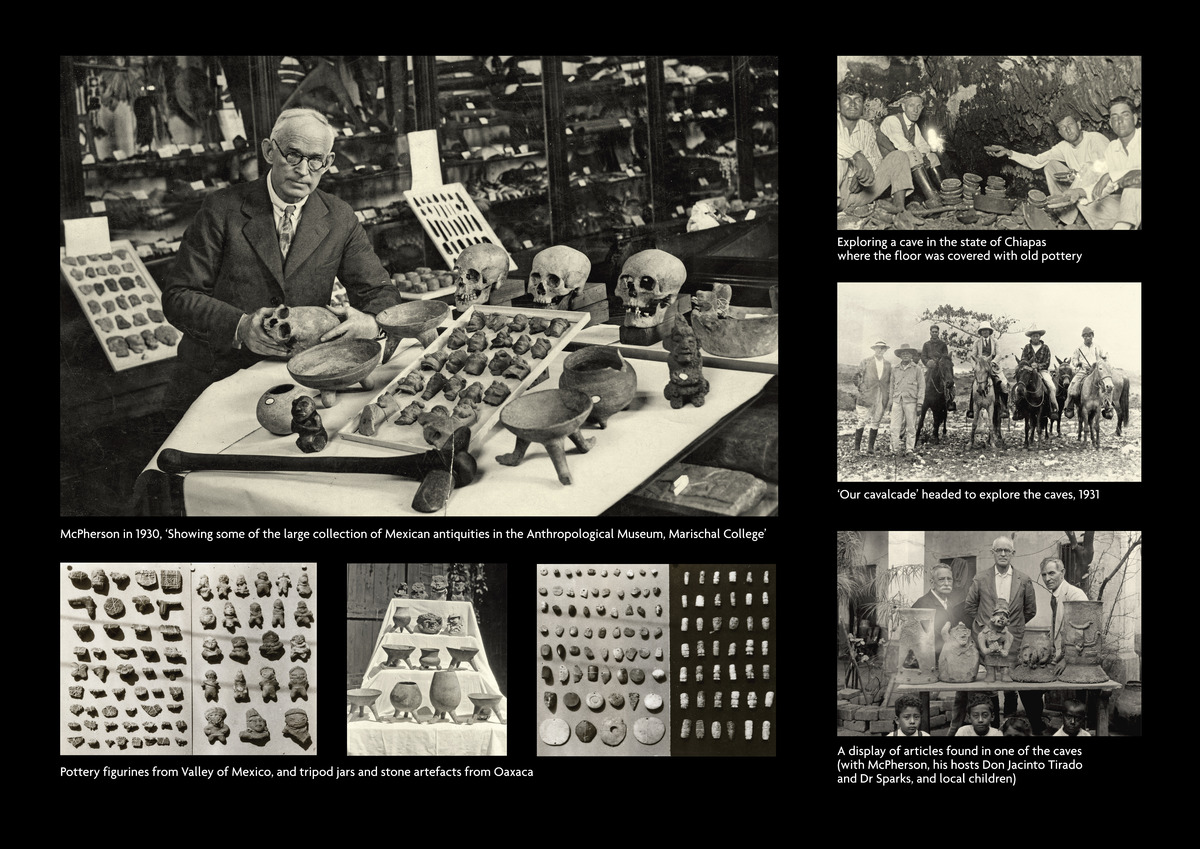John McPherson
DOCTOR IN REVOLUTIONARY MEXICO
John McPherson lived in Mexico during a time of political transitions. In 1910, a few years after he had arrived in the country, a revolution overthrew the long-standing dictatorship in the name of fair elections, access to land and better working ocnditions. From the end of the revolution in 1917 and into the 1930s, Mexico saw decades of land reform, labour militancy and social change, together with a new nationalism that glorified Mexico's indigenous cultures. Despite all this going on around him, McPherson remained remarkably detached from these political changes, concentrating on his medical work and building his collections.
An Aberdee medical graduate, McPherson worked as a doctor in Mexico and also collected antiquities almost compusively. From around 1903 he was Medical Officer at a port in the state of Oaxaca, treating workers and inspecting vessels. He left Mexico in 1925, due to ill health, but returned in 1930 when he was hired by the Royal Dutch Shell owned oil company, El Aguila, to work in oil fields in Veracruz state on the Gulf coast. When the employment of foreign doctors was legally restricted, he turned to private practice.

Photo taken by McPherson, showing Dr Sparks and Don Jacinto Tirado and, at back, the local men whose work, and probably knowledge, were vital for the expedition.
In 1921 McPherson sent his first recorded donations to the University of Aberdeen: 'some ancient Mexican skulls and other antiquities'. From then on, he corresponded with museum curator and Professor of Anatomy, Robert Reid, sending photos and stories of his growing collections. In total he donated over 1000 items to th emuseum.
Although McPherson was primarily interested in collecting pre-Columbian antiquities, he also recorded some scraps about life in Mexico, for instance nothing that stone pestles to grind corn for tortillas were being replaced by 'mills driven by electric power in the town and larger villages'. they also hint at his condescending attitude towards Mexicans, whom he described as having 'a somehwat grandiose manner'. Despite limited financial means, and legal restrictions on exporting archaeological specimesn from Mexico, McPherson's priority was to support the university's museum. He told Reid that he hoped that his donations 'will act as an added argument as to your need of more space to display your exhibits'.
McPherson collected ancient artefacts from the pre-contact past. His description of his ‘cavalcade’ to a cave in Chiapas suggests that he saw himself as something of an archaeologist, as do reference books on Mexican archaeology which he gave to the museum. McPherson generally bought these antiquities, however, rather than excavating them himself.
In his shipments to the museum, he included detailed descriptions and often photographs of both his donations and his personal collections. The carefully-staged photographs were to create interest in potential donations to Aberdeen, and may also show us one collector sharing his pleasure with museum staff, because he knew they could appreciate the work behind the display.
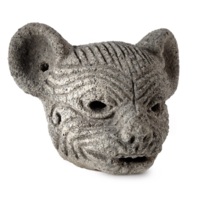
Head of a jaguar
Like many of McPherson's purchases, this small jaguar head comes from Oaxaca, where the Zapotec civilisation flourished. The jaguar is linked throughout Mesoamerica with royalty, warriors and the gods. The Zapotec saw themselves as descended from jaguars. Their god of rain and lightning had traits of the jaguar.
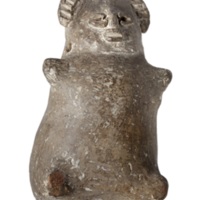
Rattle
Cultures across Mesoamerica, including the Zapotec, the Aztec and the Mayans, used clay rattles as percussion instruments.
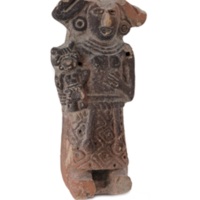
Ratttle
Cultures across Mesoamerica, including the Zapotec, the Aztec and the Mayans, used clay rattles as percussion instruments. McPherson described this Aztec rattle in the form of a woman and child as a 'Mexican Madonna', although it pre-dates contact with Christianity.
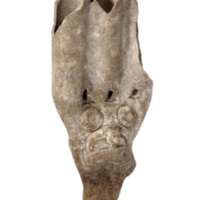
Flute
Mesoamerican cultures played many different types of wind instruments, including ceramic flutes and whistles. This instrument made from clay is probably the broken-off mouthpiece of a longer flute with three pipes. A photograph of another similar flute, intact, exists in McPherson's archives.

Idol
This statuette of a figure with a headdress and ear spools is made of white and green jadeite. Aztec craftsmen worked the jadeite without the use of metal, using stone carving tools and sand and water as an abrasive.

Beads
These large beads from Oaxaca are mostly jade, with some shell and limestone beads. McPherson displayed the beads strung as necklaces, but may have purchased the individual beads separately.

Pottery Vessel
This dish with black and red paint was made by the Toltecs, a civilization that preceded the Aztecs. It can be seen on display in the photograph of McPherson with the collections at Marischal College.

Pottery vessel
This dish was made by the Zapotecs in Oaxaca. It can be seen on display in the photograph of McPherson with the collections at Marischal College.
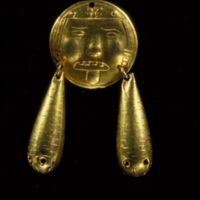
Ornament
McPherson wrote to Reid about the discovery of the tomb of a Zapotec chief at Monte Alban near the town of Oaxaca: ' The Mexicans are quite stirred up over it, and in their somewhat grandiose manner, describe it as worthy of being compared with the tomb of Tutankhamun in Egypt. I am enclosing some illustrations of gold ornaments found there, and they are very fine'. It is possible that this gold ornament is from Monte Alban, considering McPherson's interest in the site.
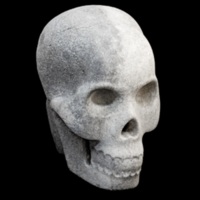
Stone skull
This stone skull was probably for a tzompantli or skull rack, large structures where priests would place the severed heads of those who had been killed as human sacrifices. Skull racks usually held real heads or skulls, but sometimes held stone carvings. They were common in Mesoamerica from as far back as 1500 BC. This skull carving was probably made around 1450-1500 AD, at the height of the Aztec empire shortly before the Spanish invasion.

'Skull cup'
Amongst McPherson's donations were a small number of human bones. The museum's director at that time, Robert Reid, was Professor of Anatomy and thus had a professional interest in human remains. McPherson described this as a 'skull cup' and it is included with his Mexican collection, but its origins are unclear. Aztecs displayed human skulls, but are not known to have used skulls as cups.
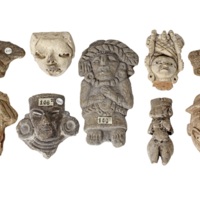
Figurine Fragments
McPherson collected many fragments of clay figurines from the Valley of Mexico. He displayed all the figurines together, but his notes show that he knew they came from many different eras and had recorded where they were found. Small clay figurines were made from the days of the earliest farmers in Mexico right up to the Spanish conquest, and are made still.
ABDUAs:8257, 8255, 8263, 8242, 8237
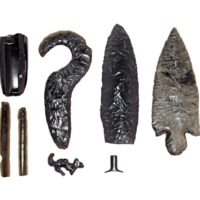
Obsidian objects
Mesoamerican cultures did not have bronze or iron, and they used obsidian, a volcanic glass, to make tools and weapons. McPherson’s collection of worked obsidian came mainly from the Valley of Mexico, which had been the main centre of Aztec civilisation. The objects include arrowheads, blades, a hook, face ornaments (a nose plug and lip plug), and a piece in the shape of an animal, maybe a jaguar or ocelot.
ABDUAs:8194, 8183, 8190, 8207, 8208, 8229, 8220, 8235, 8196, 8221, 8233
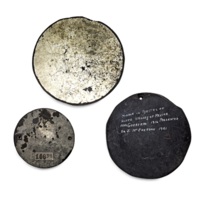
Mirrors
The Aztec god Tezcatlipoca, whose name means 'Smoking Mirror', was one of two creation gods, who represented change and conflict. He was depicted with mirrors that let him see all that was happening in the world. The term ‘smoking’ may come from the dark obsidian material used to make many mirrors but also indicates that Tezcatlipoca was mysterious. The inscriptions McPherson has added to these Aztec mirrors date them as being collected in 1916, showing that he was in Mexico during the upheaval of the Revolution.
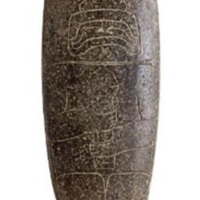
Axe
McPherson bought this decorated stone axe in 1910. It was made by the Olmec people around 1000 - 600 BC. It is made from porphyry, a hard volcanic rock that would have been difficult to carve. The decoration shows an infant version of the god of maize, who was frequently portrayed in Olmec art, especially on smaller objects which are about the size of an ear of corn. Maize is a staple of the diet in Mesoamerica and was central to culture and belief systems.

Frog or toad
This Aztec figurine from Guerrero in southwestern Mexico represents either a frog or a toad, with a human-looking face. Frogs often appeared in Aztec art as they were associated with water, rain, and fertility. Toads were also often depicted, because they secrete a poison which causes hallucinations. Aztec priests would eat tiny amounts of the poison to enter a mind-altered state.


